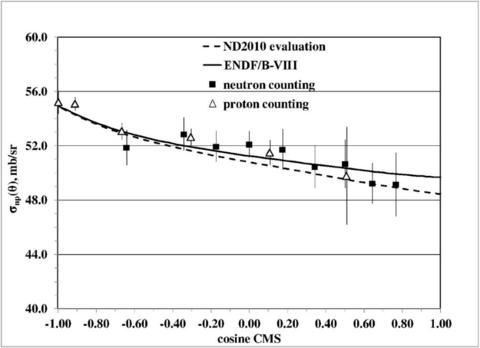Summary
NIST continues to be deeply involved with measurements and evaluations of neutron cross section standards. NIST maintains a limited experimental effort focused on improvements to the database of the standards.
Description

Shown are the present results of the hydrogen angular distribution at 14.9 MeV with neutron counting compared with those obtained by proton counting in a previous measurement by this collaboration. They are in excellent agreement. Both data sets are in excellent agreement with the ENDF/B-VIII and ND2010 evaluations, however they indicate possible lower values at forward angles.
Data from a number of NIST collaborations have produced measurements for the standards program. Measurements are underway now at NIST of the 6Li(n,t) and 235U(n,f) cross sections at sub-thermal energy. These will be the first absolute measurements of these cross sections in this energy region. These two cross sections are very important standards in the low energy region. Measurements were recently published for work on the hydrogen standard scattering angular distribution at 14.9 MeV for which neutrons were detected in coincidence with the associated proton so that data could be obtained at smaller CMS angles, A.D. Carlson in A high precision tagged neutron n-p scattering measurement at 14.9 MeV, Nucl. Sci. Eng. 194 335 (2020). This work was initiated as a result of problems that became apparent in earlier evaluations of this cross section. The data were obtained in a collaborative effort at the Ohio University accelerator facility.
A major NIST effort was the completion of an international evaluation of the neutron data standards in 2018. The neutron cross section standards from this evaluation, the H(n,n), 6Li(n,t), 10B(n,α), 10B(n,α1γ), Au(n,γ), 235U(n,f), and 238U(n,f) standards are important for the determination of evaluated cross sections for the United States nuclear cross section library, ENDF/B. All cross sections measured relative to these standards are converted to cross section using these standard cross sections. This evaluation was supported in part by the International Atomic Energy Agency (IAEA), the Nuclear Energy Agency Nuclear Science Committee and the U.S. Cross Section Evaluation Working Group. A detailed journal paper on this work was published in A.D. Carlson et al., Evaluation of the Neutron Data Standards, Nucl. Data Sheets 148, 143, (2018). Contributors to the evaluation were from Austria, Australia, Belgium, China, France, Germany, Japan, Russia, Spain, Sweden, and the U.S.A. Carlson chaired each of the working meetings leading to the evaluation. These standards were accepted for use in the most recent version of the U.S. library, ENDF/B-VIII.0. These standards are also used by the world wide nuclear data community including nuclear data libraries in Europe, China, Japan, Russia, Britain and Korea.
In an effort to continually update the standards so they will be current for use by data libraries, NIST worked with the IAEA to form a nuclear data development project, "maintenance of the neutron cross section standards". This development project provides some resources for continually improving and updating the standards. Also codes used for the evaluation process will be maintained. NIST was instrumental in leading to a more objective statistical process than that used in previous standards evaluations. This process included determination of uncertainties, correlations (leading to variance-covariance data) and preparation of the data for use in evaluations.
Additional work in the evaluation has led to reference cross sections relative to which cross sections can be measured. These cross sections are not as well known as the standards but can conveniently be used in certain applications. These include certain inelastic scattering cross sections, and fission cross sections at very high neutron energies. We continue to investigate database improvements that could lead to updates for evaluations of the 252Cf spontaneous fission neutron spectrum and the 235U thermal neutron-induced fission neutron spectrum. There is an important objective of reducing uncertainties at the highest and lowest energies for these spectra.
Measurements initiated by our standards group verified the results obtained in our evaluation of the gold cross section in the energy region related to the Maxwellian averaged cross section at kT=30 keV (MACS). This caused the astrophysics community to change their MACS value by about 5%. That MACS is now one of our standards.
Many of the standards are used directly in neutron dosimetry for fluence determination. Also, almost all measurements of other dosimetry cross sections have been made relative to neutron cross section standards. The dosimetry community requires covariances for the full energy range from 10-5 eV to 20 MeV for their evaluations. Since the standards evaluation does not cover that entire region, it at first appeared that our evaluation would not be used by them. This led to additional work which provided covariances in the regions not included in our evaluation, so now the very well defined covariances obtained from the standards evaluation process are included in the new ENDF/B evaluation.
Impact: Improved values for the standard neutron cross sections lead to similar improvements both in fundamental measurements such as absolute determination of neutron fluence and in applications using neutrons including neutron shielding for personnel protection, design of new detectors for nuclear monitoring and homeland security, and design of next-generation nuclear reactors and isotope production facilities.

